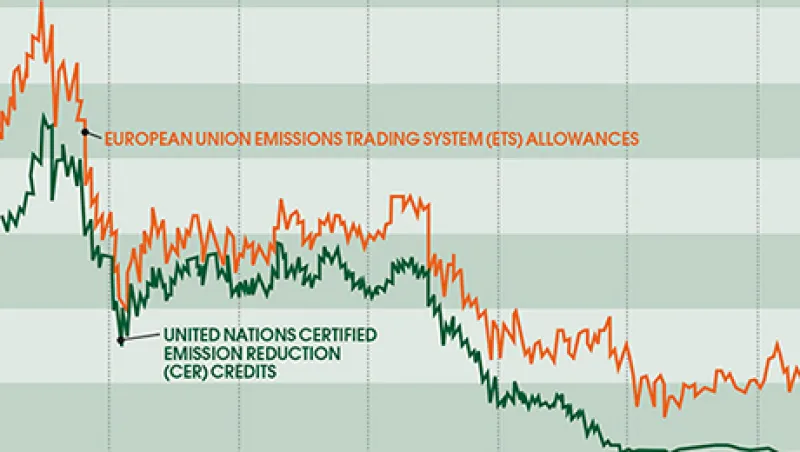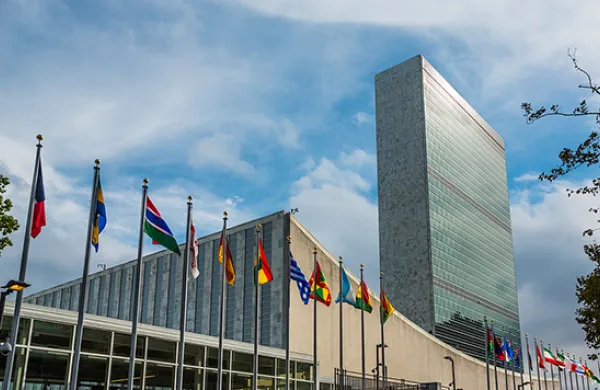Judging from the flurry of recent launches, carbon markets are booming. Eight new venues opened for business in 2013, and roughly 40 countries and 20 subnational jurisdictions elsewhere have a put price on carbon dioxide, according to a May report from the World Bank Group. The total value of carbon credits being traded in these markets is about $30 billion.
Notwithstanding all of this activity, the emissions pricing and trading concept has yet to take off. As more governments get on board, the price of credits is falling, prompting experts to admit that they’re losing faith in carbon markets as a tool to tackle climate change. “The jury is definitely still out on whether carbon markets are working,” says Anja Kollmuss, a Zurich-based senior policy researcher at Carbon Market Watch, a watchdog group based in Brussels. “In theory, they’re beautiful policy instruments,” Kollmuss notes. “But the thing is, how do they work in a political reality?”
By putting a price on carbon dioxide, governments hope to encourage heavy emitters of the greenhouse gas to build cleaner factories and make other climate-friendly investments. In cap-and-trade schemes like the European Union Emissions Trading System (ETS), governments limit corporations’ total annual emissions and auction or otherwise distribute allowances for each metric ton of carbon. Companies that exceed their caps must buy more allowances, and those under the limit can sell their credits directly to heavier polluters or on the open market. Other approaches tax carbon or facilitate the trading of carbon offsets without the cap on emissions.
But most governments have been too lenient with emissions targets, Carbon Market Watch’s Kollmuss says; the result is an oversupply of carbon credits and little incentive for companies to change. As of May, the price of an ETS allowance had fallen to just over €5 ($7), from a peak of some €32 in April 2006. The United Nations’ Clean Development Mechanism, which allows developed countries to earn certified emission reduction (CER) credits for funding emissions-reducing projects in the developing world, has seen CER prices plunge from a high of nearly €23 in July 2008 to less than €0.10 this May.
“We are concerned about the drop in the price of CERs, and we’re anxious to get that back up,” says Hugh Sealy, chair of the CDM’s executive board. To boost demand, the initiative is letting individuals, companies, churches, governments and other institutions buy credits and cancel them to “morally offset” their own emissions, explains Sealy, a professor with the School of Medicine at St. George’s University in Grenada. The CDM hopes to launch a public website for that purpose by November.
Much of the recent government interest in carbon markets stems from the World Bank’s Partnership for Market Readiness. Through April developed-market partners had pledged $126.5 million to this effort, which props up developing nations’ emissions-pricing programs, offers technical assistance and hosts discussions between carbon market experts and newcomers. But Adrian Rimmer, London-based CEO of the Gold Standard Foundation, a Swiss nonprofit that sets certification standards for carbon mitigation projects, says he’s noticed more corporations seeking to apply carbon-pricing methodologies within their industries.
Take Akzo Nobel, an Amsterdam-based paints and coatings company that has developed a hull coating called Intersleek. Akzo Nobel touts Intersleek as so low-friction that it makes ships more fuel-efficient. But the product also costs more than traditional hull paints, so the company wanted to address the so-called split incentive created when a ship owner isn’t benefiting from the potential fuel savings that come with operating the enhanced vessel. With Rimmer’s GSF, Akzo Nobel devised a system for comparing a ship’s pre- and post-Intersleek fuel consumption and then generating carbon credits for both the owner and the operator.
Rimmer says this approach could work in other transportation industries, such as air travel, and in the real estate business, where split incentives discourage building owners and renters from investing in energy-saving upgrades. The Akzo Nobel project also shows that nongovernmental actors can apply carbon market methodologies on a relatively small scale, he adds. “There has been a slight wobble in confidence in carbon markets,” Rimmer says. “But I think that’s mitigated by the fact that there’s a lot of new experimentation going on.” • •
Get more on macro.






